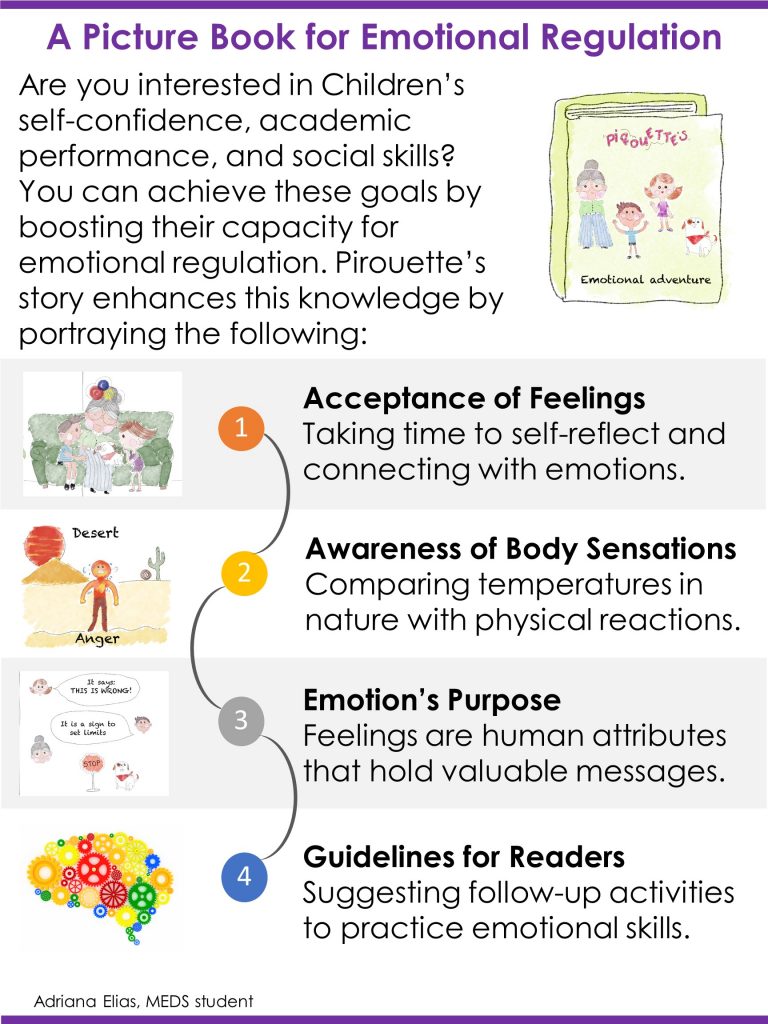Adriana Elias, MEDS student
The video below presents a picture book for emotional regulation. This picture book is written in Spanish and has English audio. Besides, the infographic summarizes the main concepts depicted in the story. Through this applied project, I developed this story to reinforce emotional skills like identifying feelings and communicating them. Whit this learning tool, readers can practice acceptance and understanding of feelings using curiosity and kindness. Emotional abilities can reinforce other skills, like boosting self-confidence, improving performance, developing decision-making skills, supporting independence, and enhancing sociability. The earlier we start this learning process, the better children can master these abilities and improve wellness.

References:
- Domitrovich, C., Durlak, J. A., Stanley K. C., & Weisberg, R. P. (2017). Social-Emotional competence: An essential factor for promoting positive adjustment and reducing risk in school children. Child Development, 88(2). https:/doi.org/408-416. 10.1111/cdev.12739
Cambridge University Press (2021). What is dialogic reading? https://www.cambridge.org/elt/blog/2019/04/18/dialogic-reading/ - Breugelmans, S., Ambadar, Z., Vaca, J., Poortinga, Y., Setiandi, B., Widiyanto, P., & Philipot, P. (2005). Body sensations associated with emotions in Raramuri Indians, rural Javanese, and three student samples. American Psychology Association, 5(2), 166-174. https://doi.org/ 10.1037/1528-3542.5.2.166
- Goleman, D. (1995). Emotional intelligence. Bantam Books.
- Nummenmaa, L., Glerean, E., Hari, R., & Hietanen, J. (2013). Bodily maps of emotions. Proceedings of the National Academy of Sciences of the United States of America PNAS, 111(2), 646-651. https://www.pnas.org/content/111/2/646
- Llenas, A. (2012). The color Monster. Flamboyant.

Hi Adriana. I really like your topic and research questions. They definitely gave me some food for thought. I also really like the use of picture books when working with students. Your creation of the picture book is very beautiful. How did you create it? Did you use any technology? I also like how you book has been created in both English and Spanish. Do you plan on trying to get a print version of it published? I agree with you on the importance of teaching children the importance of emotions. Thank you for reminding me about this topic. Best wishes in your project journey!
Hi Melissa!
Thank you for your comments. I’m glad you want to use picture books with students; there is so much evidence about their effectiveness for learning purposes. All the best to you!
I created the picture book using the app “Procreate.” It is a tool for sketching and painting. It has been a lot of fun but challenges because I did not have experience drawing. Fortunately, I had some tips and tricks from two artists and online tutorials. And yes! I want to have a print version of the picture book and publish it. That will be the next step!
Thanks Adriana for the wonderful way of presenting your learning. I learned too and I think making the connections between natural landscapes and phenomena and emotions is a valuable tool for working with children. I am wondering, when helping children recognize and name their emotions – are there some emotions that should be emphasized first, or early on? And others that should wait for more emotional maturity?
Hi Rachell,
Thank you for your comments.
From my perspective, basic emotions are a good choice to start reinforcing from early childhood because those feelings are aligned with their young experience. From the literature review of this project, I have learned that the first emotions experienced are joy, anger, sadness, and fear since the early years of life.
Adriana! What a beautiful way to represent your learnings – a picture book. I love the analogies/chart that link the physical responses to the emotions (and of course your fun artwork). Every year I am asked by first year students, what can my MEd LOOK like? I will certainly add this as a unique example of how there is space for creativity in the program. Can I ask your pathway to arriving at the picture book? How did you come to this idea?
Hi Wendy!
Thank you for your comments.
The pathway started with my experience using picture books in a one-on-one therapy environment for emotional regulation and discovering that I could use this strategy in school settings. I wanted to design a picture book with basic concepts about emotions, such as accept all emotions and explore their purpose. I found out that one way is to be aware of our body cues. Then, I looked for analogies to represent these abstract ideas. Finally, I depicted children as the characters that can lead the journey of exploring emotions. Most of the time, children characters are portrayed as the ones with challenges, not solutions.
Hi Adriana!
I love the fact that your main character (the one that is struggling with emotions) is an adult! It really gives the children the power. This is such a nice change from other story books that put the children in the space of not understanding emotions.
The natural connections is something so different as well! What an interesting adaptation to the colours that everyone else seems to be using.
I really love the creativity and uniqueness of your project! I would love a copy in English and in Spanish!
Thanks for sharing!